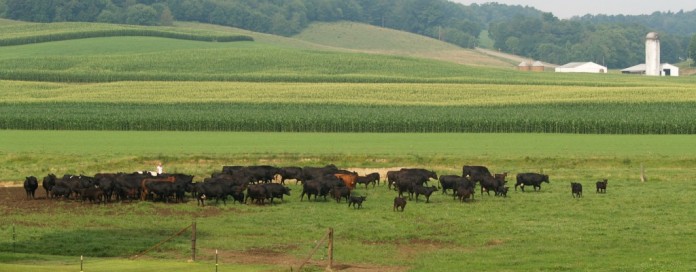Late summer can be challenging for those who are raising a few animals on 5 to 10 acres or sometimes less. Continuously changing weather conditions can make pasture management even harder.
During the end of June and part of July in eastern Ohio, we experienced drought conditions. Following the drought, fluctuations in storm events have been scattered, one part of the county may get four inches of rain and the rest get none.
In these types of weather events, good pasture management practices are important whether you have 5 acres or 100 acres of pasture. Small acreage livestock production could be a mixture of cows, sheep, goats, swine, poultry and even a horse or two.
These animals in different combinations and numbers can cause overgrazing and soil damage in drought conditions if they are not adequately managed to prevent it. To keep our small acreage healthy and productive we must adopt some management practices.
Soil testing
First, if you haven’t had your pastures soil tested before, fall is a great time to get it done. We recommend that you have your soil tested every three years. Proper fertilization of your pastures is very important to maintaining high-quality forage for your animals.
Knowing your soil pH and nutrients, N-P-K, will help you determine if your pastures need fertilizer or lime. The soil test will also help you save money by enabling you to purchase the exact amount of nutrients your pastures need.
Remember, nitrogen is a critical nutrient for forage quality and growth. Phosphorus helps improve forage quality and root development, while potassium improves the plant’s ability to survive during periods of drought and freezing winter temperatures and conditions.
Mowing
Mowing your pastures is another way to keep them productive this time of year. Mowing can help maintain high-quality and productive forage vegetation. It can also limit the growth of weeds by removing some weed species and seeds from others.
Mowing at the right height is important to maintaining the health and survival of pasture grasses. When mowing, maintain a height of 2 to 3 inches for fine-bladed short grass species such as perennial ryegrass and bluegrass. Mow at a higher level of 3 to 5 inches for higher-yielding species, such as orchard grass or timothy.
Rest and rotation
Don’t forget that sometimes pastures need to be allowed a rest, especially on small acreage farms. Rotational grazing systems improve your pastures productivity by allowing forages to restore their energy reserves so that they can continue to grow and produce.
Pasture rotation in drought situations is essential to good pasture productivity. As a good rule of thumb, turn animals into pasture when the grass is 7 to 10 inches tall or taller and allow them to graze until it is down to 3 to 4 inches before moving them to the next pasture.
During drought conditions on limited acreage, we need to plan for an Animal Concentration Area. This is because our pastures are drying up and not producing enough forage for our animals to eat.
ACA’s are also areas that are known as sacrifice lots, barnyards, dry lots or heavy-use pads. These areas are used to confine the animals with access to hay and water, while we allow the pastures to rest and hopefully start regrowing once the drought is over.
Sometimes the drought can be extremely hard on our pasture grass species so we may have to do a pasture renovation to improve the stand density and introduce new grass species into our pastures.
Late summer/early fall is the ideal time of year for reseeding pastures. Spring is another time that pastures can be reseeded, but new seedlings have to compete with drought and higher weed competition during hot, dry summer conditions. Early fall plantings give the seedlings a better chance of becoming established.
Manure can be another issue when it comes to small farm pastures. Dragging your pasture a couple of times a summer — a good practice is to do it each time after you mow — will help distribute and break up those manure piles.
Summary
If you want to boost your small farm pasture productivity, follow these simple suggestions:
• Use rotational grazing, don’t overgraze or overstock your pastures.
• Every pasture needs to rest and regrow.
• Soil test every three years and fertilize and lime when needed.
• Use a sacrifice lot as needed especially during times of drought.
• Mow after each grazing rotation and control weeds.
• Drag your pastures a couple of times a year.
Follow these simple suggestions and you will have productive pastures that both you and your animals will enjoy.













